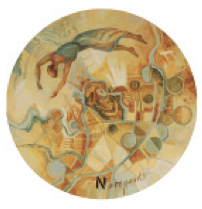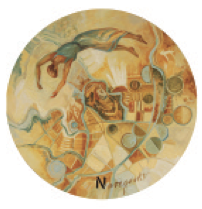Lydia Rubio
Beaux-Arts des Amériques, Montreal
The title of Lydia Rubio’s exhibition at the Beaux-Arts des Amériques, L’Étrangère (The Foreigner), evokes the title of Albert Camus’s famous book, although the artist obtained inspiration from a poem by Marjorie Agosin. Unlike the traveler who is indifferent to the absurdity of what sur- rounds him, “The foreigner” sets out on her travels as if trying to decipher a meaning, a clue, as she journeys on. This becomes evident in the progressive revelation of linguistic signs in the paintings that structure her polyptychs in sub-series that nar- rate different sojourns in the course of her trip.

The exhibition features a series of five works that show The Foreigner moving along a fiery yellow land. The word “world” is gradually built through the inscription of a single letter in each work. On the other hand, there is a use of images essem- tially associated to the collective unconscious, such as the boat, which alludes to migrations, or the house associated to the self. While the recurring representation of the island contains an allusion to her own condition as an artist in exile, her symbol- ogy of uprooting is existential and related to gender issues. The Foreigner flies, taking with her the island with the house and the boat; or she runs along the fields carrying the boat on her back; or she supports the weight of the world with her hands, like a female Atlas. In all the mentioned cases, the load is a hindrance or a heavy weight, and the feet − represented almost as blots − are not firmly planted.
These diurnal and terrestrial works are preceded by four graph- ic works (two diptychs) associated to the cosmic night and to the formation of the word “Fata”, oracle. Each title corresponds to a fragment of one of Agosin’s verses, and to another stage of the trip. Pyramidal figures emerge, and so does the same geometric spiral based on the Nautilus that she used in a mon- umental public sculpture. The traveler gradually unbinds her- self. Now she stands upon the world or upon the island, or han- dles a weight lightened by the use of threads, or floats on a higher plane above the house, the boat and the island, which sail adrift. The segmentation of the paintings in two drastical- ly divided backgrounds constitutes an allegory. There is a lib- eration from weight, but not a full integration. The journey continues and it becomes a third ensemble, now made up of a triptych of oil paintings illustrating a cosmic integration. The foreigner is no longer an “alien” in this environment; it does not weigh down upon her and she does not detach herself from it: she executes a sort of blue dance that includes the partici- pation of the sea, the island and the sky, as well as of essential geometric figures and the mirrorlike play of the painting with- in the painting. Only then does Visa pour un rêve emerge: the unique, circular work in which The Foreigner is portrayed as the swimmer who pulls the boat of her triangular universe effortlessly from one side to the other within the frame of a white square. In the exhibition, the paper boats taken from this work establish a thread of continuity with the drawing sketch- es on artisan paper and the layout of the Passport, the evidence of foreign status but also the permit to travel freely from one place to another. Sequential creation and the interplay of cor- respondences are decisive. Somehow there are no loose pieces, and the definitive pictorial version of a work does not have, in and of itself, the same relevance as the integral proposal that is structured, precisely, as a complete world in which graphic design, with a strong textual context, and the artist’s books that function as a logbook recording thought and creation processes, are essential. Rubio thus gathers together the artisanal − taking particular delight in calligraphic aesthetics − and the exploration of the artwork that can be read at the moment of its creation not only in an iconographic way but also textually. There is no doubt that any exhibition of hers must include these artistic notebooks that contain what is untransferable in her work.





